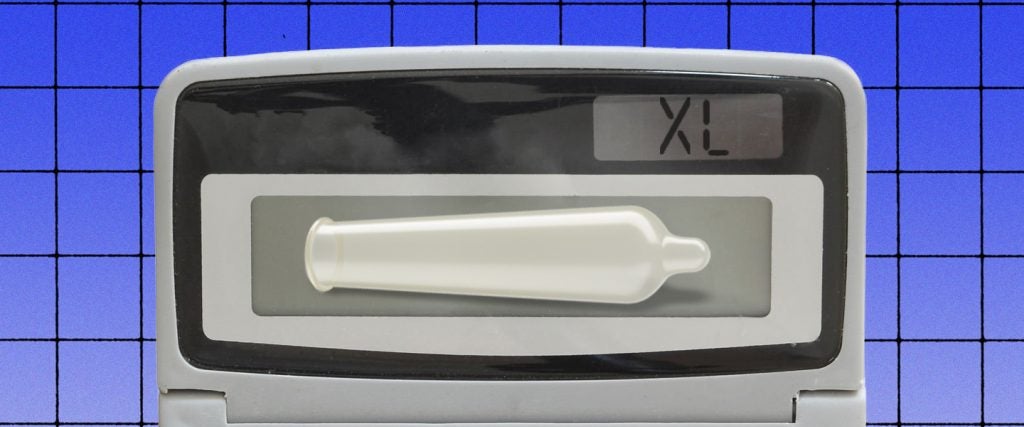As a woman without a penis, I’ve never much thought about the process of buying condoms, let alone what size you’re meant to buy, or how you know what size you are. I’ve heard of Magnums, and I’ve heard of regular-sized condoms, but that’s it. And, as it turns out, my knowledge isn’t actually that far off from many men’s. A quick Reddit search will unearth a number of men seeking advice on what condom size to buy, or how to measure their dicks to establish the right one. “Hey, uhh, I got 5.5 to 5.9-inch girth and about 7.2-inch length,” wrote one user. “I read that the penis should be 80 to 90 percent of the condom size for the lowest chance of slippage/breakage. I don’t know if that’s true, and also when I look at the condoms they say 53 millimeters, 56 millimeters and 60 millimeters, but like I’m 47 millimeters in width, so I’m confused. Can you help me?”
This isn’t the only befuddled penis owner. According to a 2017 study, just a third of American men use condoms, which, says The New York Times, is partially because of their perceived poor fit. Another study backed this reasoning up, finding that 83 percent of men had penises shorter than standard condoms (the average penis length is between 5.1 and 5.5 inches, and the standard condom length is 7.25 to 7.8 inches). When not used correctly — including not fitting properly — condoms are just 85 percent effective, as opposed to 98 percent if used perfectly every single time.
As the authors of yet another study once wrote: “Condoms need to fit correctly to guard against fluids and exposed skin which could lead to STD contraction or pregnancy.” These authors explain that, to find the right size, “the girth (the width of an erect penis) is the most important factor, not length.” However, they continue, “most condom companies do not list their normal width, let alone base their sizes off girth.” Because of this, “men complain about the lack of simplicity and intuitiveness when finding a condom that fits them.”
Which is the problem condom size calculators are aiming to remedy. There are a number of these measurement sites online, all of which ask users to enter their penis size (girth and length) before suggesting a suitable condom make and model for their specific dick. So, for example, our friend from the Reddit post above would find a Pasante King Size condom (5.2 to 5.9-inch girth) to be a “tight” fit, while a Durex XXL (5.4 to 6-inch girth) would be a “normal” fit — at least according to the calcSD calculator, anyway. Another calculator, at Condom-Sizes.org, churns out the same results, as does The Big Dick Guide. The r/BigDickProblems subreddit also offers a couple of other condom measuring links in its FAQ (one person in the group even shared a very helpful guide to sizing).
But, as noted by several commenters on Reddit, these calculators don’t always have the answer either. “The two most recent condoms I’ve tried are Trojan Supras (too tight, don’t go all the way down) and Bareskin Magnums (perfect length, but gets vertical wrinkles at the top near the head),” said one user. “The Magnums are 100 times more comfortable than the Supras, and the condom size calculators say they should fit, but I’m not sure what to make of the wrinkles. Are wrinkles near the top normal, or does that mean it’s too big?”
Because you (obviously) can’t try them on in the stores, for those questioning their size, it’s worth buying several condom fits and trying them on — even alongside using a condom calculator, which can give you a good idea of which ones to start with. Most sex shops also have single condoms from many brands available, so you can buy a few and try them without breaking the bank.
And if you’re a Magnum, congrats my guy!

